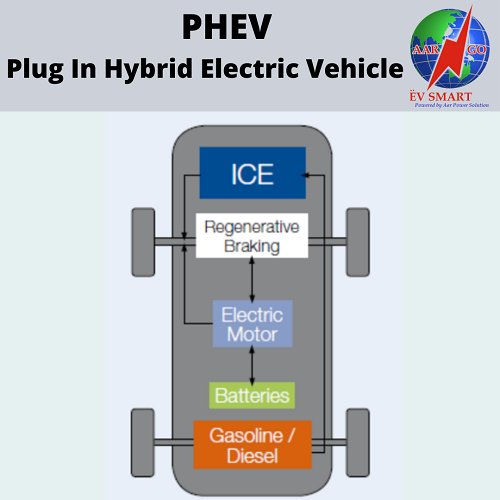There are three types of electric vehicles categorized by the amount or degree that electricity is used as a source of power.
There are three types of electric vehicles categorized by the amount or degree that electricity is used as a source of power.
- HEVs Hybrid Electric Vehicles
- PHEVs Plug-in Hybrid Electric Vehicles
- BEVs/AEVs Battery Electric Vehicles/All-Electric Vehicles
HEVs Hybrid Electric Vehicles
The hybrid electric vehicle has both a conventional internal combustion engine (ICE) and an electric-powered propulsion system. HEVs use both petrol and electricity as power, HEVs startup using electric motor then the petrol engine takes over as the speed rises.
In this the batteries are charged by its regenerative braking system, this system is a mechanism that recovers the energy by slowing down a moving vehicle, which converts kinetic energy into electrical energy, which is stored in batteries or supercapacitors, or the energy is directly used by the motor in some vehicles.
Both the Internal combustion engine and electric motor are controlled by computer software which ensures the best fuel economy and leads to fewer tailpipe emissions as compared to traditional vehicles with an internal combustion engine.
PHEVs Plug-in Hybrid Electric Vehicles
We can say Plug-in Hybrid Electric Vehicle is a combination of both the Hybrid electric vehicle and battery electric vehicle, it combines an internal combustion engine with a battery-powered motor like a hybrid vehicle whose batteries can be charged by plugging into an external source of electric power.
The plug-in hybrid vehicle also uses the regenerative braking system for recharging batteries with the plugging in an external source of electricity. Because of the plug-in rechargeable system, the operating cost of PHEVs reduces as charging from the grid might cost less than charging of batteries from an onboard generator.
PHEVs can run longer only on electricity when charged full than HEVEs which extend the range of the vehicle which ultimately leads to fuel economy and less emission by a vehicle.
BEVs/AEVs Battery Electric Vehicles/All-Electric Vehicles
BEVs battery electric vehicles are also called all-electric vehicles or only EVs or pure electric vehicle. The electric vehicle has onboard batteries whose power is used to operate the electric motor with no other secondary fuel engine (internal combustion engine).
The vehicle store the electricity in chemical form in high-capacity batteries or supercapacitors present onboard thus not required any fuel tank or fuel cell. Unlike the traditional internal combustion engine, BEVs runs with zero-emission and no other harm to the environment.
The range of an all-electric vehicle depends on the vehicle but the average range of vehicle available in the market is 200 km and few luxury and performance vehicle has a range of 450 km.
BEVs completely powered by batteries onboard, which are charged from external sources with the help of special chargers, and the charging speed is dependent on the type of charger. The chargers are classified by the speed of charging.
Generally, there are three types of EV chargers available are, level 1, level 2, level 3, or DC fast charger. 1) Level one takes almost 8 to 10 hours to fully charge an EV, and it uses standard 120volts outlet to charge.
Read More:-What are the types of Electric Vehicles?








